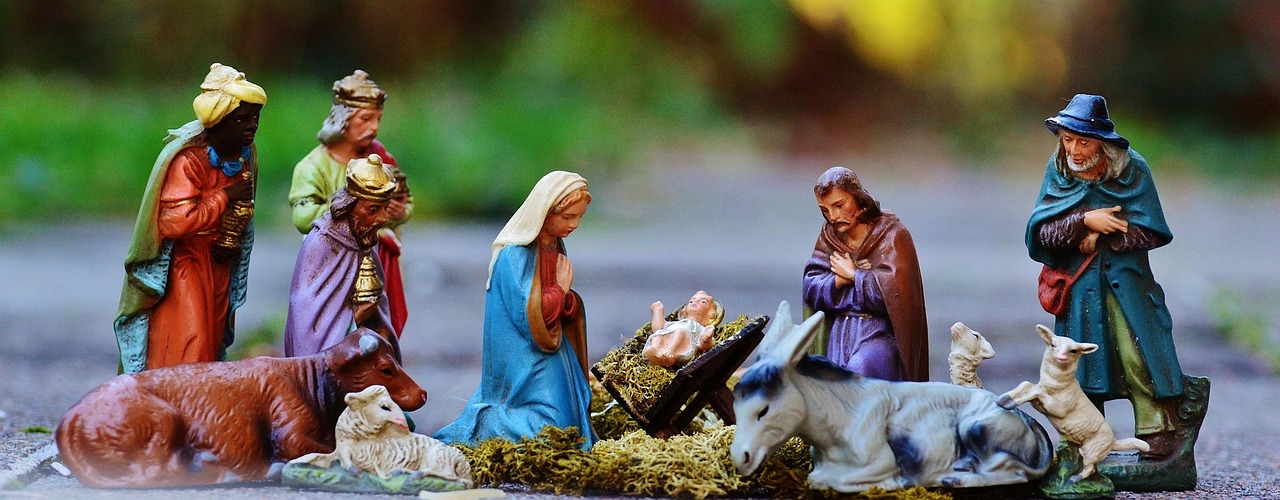Archeological Information About The First Christmas
One of my favorite parts of writing historical fiction is researching in order to build an accurate picture of the characters' lives. In this series, I share some of the insights I've gathered. Check out the book links below to hear your favorite Bible characters share details from their lives.
This is my research compilation for a Christmas anthology due to release in fall of 2024.
You'll hear from Mary and Joseph and their parents. A shepherd, a traveler, and a scribe will also tell their stories. Join the Scribbles team to get updates on writing and insights I discover on the way.
The links below are not fully vetted at this point. Please proceed with wisdom and learn alongside me. Leave a comment if you have updated information on any topic - contrary or supporting. I love a good, respectful conversation!
Our information about the birth of Jesus comes from Matthew 1-2 and Luke 1-2, plus 2,000 years of tradition. Our duty is to separate the tradition from the scripture to know the Truth. Some of what I present in this research, and later in the stories, flies in the face of tradition. But, to the best of my ability, it holds true first to scripture, then to the historical evidence. And.... once we understand the historical and cultural context, the questions and supposed inaccuracies in the Biblical narrative are answered.
Do you have additional resources I should know about? Please comment.
When was Jesus born?
- John 2:20 the Pharisees tell Jesus it has taken 46 years to build the temple. Herod began building in 20 (or 19?) BCE (Josephus). Jesus began his public ministry when he was about 30 years old (Luke 3:23). If this was the first Passover of His ministry, it would have been about 26 AD (there is no year "0" between 1 BCE and 1 AD). Thus, he would have been born around the year 4 BCE.
- Side note: the temple wasn't completed until 63AD, a mere 7 years before its total destruction.
When Quirinius was governor
- Problem: Josephus records Quirinius' time of governing Syria beginning in 6AD. There is no overlap of Quirinius and Herod according to this timeline. Hint: Quirinius ruled in Syria twice.
- Solving the Census of Quirinius https://jcalebjones.com/2020/10/27/solving-the-census-of-quirinius/?amp=1
- These, which may be called the regular taxes, were irrespective of any forced contributions, and of the support which had to be furnished to the Roman procurator and his household and court at Caesarea. To avoid all possible loss to the treasury, the proconsul of Syria, Quirinus (Cyrenius), had taken a regular census to show the number of the population and their means. (Edersheim, Sketches of Jewish Social Life)
- Biography of Quirinius. Includes a comprehensive list of historical references to Quirinius
Elizabeth
- Hiding away https://biblical-thinking.org/cgi-bin/article.pl?033Luk
- We can scarcely be mistaken in supposing, that then, as now, a benediction was spoken before circumcision, and that the ceremony closed with the usual grace over the cup of wine, [742] when the child received his name in a prayer that probably did not much differ from this at present in use: Our God, and the God of our fathers, raise up this child to his father and mother, and let his name be called in Israel Zacharias, the son of Zacharias. [743] Let his father rejoice in the issue of his loins, and his mother in the fruit of her womb, as it is written in Prov. xxiii.25, and as it is said in Ezek. xvi.6, and again in Ps. cv.8, and Gen. xxi.4;' the passages being, of course, quoted in full. The prayer closed with the hope that the child might grow up, and successfully, attain to the Torah, the marriagebaldachino, and good works.' [744] (Edersheim, Life and Times of Jesus the Messiah)
- [4 According to St. Luke 1:7 they were both 'well stricken in years.' But from Aboth 5:21 we learn, that sixty years was considered 'the commencement of agedness.'] Life and Times of Jesus the Messiah, Edersheim, Ch III The Annunciation of Ts. John the Baptist, Kindle ed
Nazareth
- That along the north of the plain is formed by the mountains of Lower Galilee, cleft about the middle by a valley that widens, till, after an hour's journey, we stand within an enclosure which seems almost one of Nature's own sanctuaries. As in an amphitheatre, fifteen hill-tops rise around. That to the west is the highest - about 500 feet. On its lower slopes nestles a little town, its narrow streets ranged like terraces. This is Nazareth, probably the ancient Sarid (or En-Sarid), which, in the time of Joshua, marked the northern boundary of Zebulun. [675] [676] (Edersheim, Life and Times of Jesus the Messiah)
- For, the Galilee of the time of Jesus was not only of the richest fertility, cultivated to the utmost, and thickly covered with populous towns and villages, but the centre of every known industry, and the busy road of the world's commerce. Ibid
- Just outside the town, in the north-west, bubbled the spring or well, the trysting-spot of townspeople, and welcome resting-place of travellers. Beyond it stretched lines of houses, each with its flat roof standing out distinctly against the clear sky; watered, terraced gardens, gnarled wide-spreading figtrees, graceful feathery palms, scented oranges, silvery olive-trees, thick hedges, rich pasture-land, then the bounding hills to the south; and beyond, the seemingly unbounded expanse of the wide plain of Esdraelon! Ibid
- Hence, although the stream of commerce between Acco and the East was divided into three channels, yet, as one of these passed through Nazareth, the quiet little town was not a stagnant pool of rustic seclusion. Men of all nations, busy with another life than that of Israel, would appear in the streets of Nazareth; and through them thoughts, associations, and hopes connected with the great outside world be stirred.
- But, on the other hand, Nazareth was also one of the great centers of Jewish Temple-life. It has already been indicated that the Priesthood was divided into twenty-four courses,' which, in turn, ministered in the Temple. The Priests of the course' which was to be on duty always gathered in certain towns, whence they went up in company to Jerusalem, while those of their number who were unable to go spent the week in fasting and prayer. Now Nazareth was one of these Priest-centres, [678]
Joseph
- Where was he from? https://jcalebjones.com/2020/05/15/are-you-sure-you-know-josephs-hometown/?amp=1 (I found this article while researching for this series. I've not heard the theory before. I'm posting it here so I don't lose it while waiting to talk to my smart people about it. I'd love to hear your thoughts.)
Born in a Manger (but not a barn)
- https://biblearchaeology.org/research/chronological-categories/life-and-ministry-of-jesus-and-apostles/4866-away-in-a-manger-but-not-in-a-barn-an-archaeological-look-at-the-nativity
- https://www.psephizo.com/biblical-studies/does-it-matter-that-jesus-wasnt-born-in-a-stable/
- https://www.psephizo.com/biblical-studies/jesus-was-not-born-in-a-stable-honest/
- All this, of course, applied to entertainment in private families. On unfrequented roads, where villages were at great intervals, or even outside towns (Luke 2:7), there were regular khans, or places of lodgment for strangers. Like the modern khans, these places were open, and generally built in a square, the large court in the middle being intended for the beasts of burden or carriages, while rooms opened upon galleries all around. Of course these rooms were not furnished, nor was any payment expected from the wayfarer. At the same time, some one was generally attached to the khan -- mostly a foreigner -- who would for payment provide anything that might be needful, of which we have an instance in the parabolic history of the Good Samaritan (Luke 10:35). Such hostelries are mentioned so early as in the history of Moses (Gen 42:27; 43:21). Jeremiah calls them "a place for strangers" (Jer 41:17), wrongly rendered "habitation" in our Authorised Version. In the Talmud their designations are either Greek or Latin, in Aramaic form -- one of them being the same as that used in Luke 10:34 -- proving that such places were chiefly provided by and for strangers. [14] (Edersheim, Sketches of Jewish Social Life)
Jesus' first months
https://www.angelfire.com/nt/theology/lk02-21.html
Life in First Century Israel
That the World may Know https://www.thattheworldmayknow.com/inside-first-century-home
Four-room Israelite Home https://www.biola.edu/blogs/good-book-blog/2021/an-israelite-four-room-house-at-hazor-biola-learn-s-the-geography-of-israel
Travelers and Hospitality
- Israel was always distinguished for hospitality; and not only the Bible, but the Rabbis, enjoin this in the strongest terms. In Jerusalem no man was to account a house as only his own; and it was said, that during the pilgrim-feasts none ever wanted ready reception. The tractate Aboth (1.5), mentions these as two out of the three sayings of Jose, the son of Jochanan, of Jerusalem: "Let thy house be wide open, and let the poor be the children of thy house." Readers of the New Testament will be specially interested to know, that, according to the Talmud (Pes.53), Bethphage and Bethany, to which in this respect such loving memories cling, were specially celebrated for their hospitality towards the festive pilgrims. In Jerusalem it seems to have been the custom to hang a curtain in front of the door, to indicate that there was still room for guests. Some went so far as to suggest, there should be four doors to every house, to bid welcome to travellers from all directions. The host would go to meet an expected guest, and again accompany him part of the way (Acts 21:5). The Rabbis declared that hospitality involved as great, and greater merit than early morning attendance in an academy of learning. They could scarcely have gone farther, considering the value they attached to study. Of course, here also the Rabbinical order had the preference; and hospitably to entertain a sage, and to send him away with presents, was declared as meritorious as to have offered the daily sacrifices (Ber.10, b). (Edersheim, Sketches of Jewish Social Life)
- To adopt and bring up an orphan was regarded as specially a "good work." This reminds us of the apostolic description of a "widow indeed," as one "well reported for good works"; who "had brought up children, lodged strangers, washed the saints' feet, relieved the afflicted, diligently followed every good work" (1 Tim 5:10). Indeed, orphans were the special charge of the whole congregation -- not thrust into poor-houses, -- and the parochial authorities were even bound to provide a fixed dowry for female orphans. (Edersheim, Sketches of Jewish Social Life)
Sheep Towers and swaddled, temple lambs
- As I stated above, as bearers of the Truth, it is our duty to test everything and to hold to the Truth. He does not need embellishment nor help being spectacular.
- Were the shepherds in the service of the Temple or even priests? There is no evidence from the time of Christ that this is the case. The only writings we have mentioning this practice are from the Jewish Mishnah written 200 years later -- nearly a century and a half after the temple was destroyed and sacrifices ceased. So, possibly, but probably not.
- Migdal Eder (the sheep tower). The story goes that Migdal Eder was a sheep tower located yards from Bethlehem. This is where the shepherds would take their lambs to birth and this is where Mary and Joseph found shelter to give birth to Jesus and laid him in the very mangers of the lambs set aside for temple sacrifice. BUT there is no evidence of this. We do not know where Migdal Eder is. It is mentioned with Bethlehem in Genesis 35, but we have no idea how close one is to the other. The other time the tower is mentioned in the Bible is Micah 4:8. But, the next line renames Migdal Eder as "hill of the daughter of Zion," pointing to Jerusalem, not Bethlehem.
- Special temple sheep and swaddled lambs? They claim is that the shepherds were raising sheep destined to sacrifice in Jerusalem and that, when a perfect lamb was born, it would be swaddled and laid in a manger so it would not be injured. I have not found any evidence that sheep from Bethlehem were considered best for sacrifices nor that shepherds ever swaddled lambs. To the contrary, having lived on a farm and watched many animals being born, I would guess that swaddling would prevent their muscles from developing properly, thus crippling them.
In Our Stories, your favorite Bible characters hold nothing back as they share their anger, pain, failures, joys, and successes. You'll find people whose lives weren't so different from yours.
Our Stories of Christmas is not, yet, available. But check out the other stories in this series.
Connect with Me:
Picture Credit: Alexas_Fotos on Pixabay




Comments ()